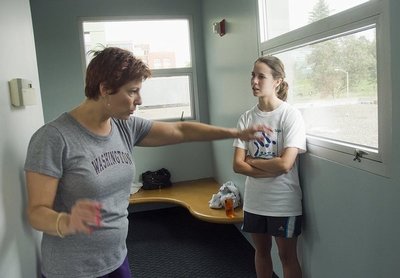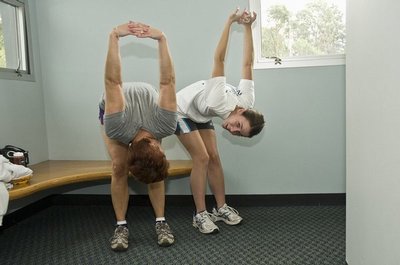October 14, 2010
Treating the paradox of paradoxical vocal fold motion
Sometimes in her work at the UW, Julie Dunlap puts on her shorts and running shoes. But she isn’t a coach for any of the athletic teams; she’s a speech pathologist. The unusual gear is needed when she works with young athletes to help them address a malady that affects their performance.
The malady is called paradoxical vocal fold motion, or PVFM, and it can affect anyone, but it is most common in athletes, especially female athletes. Many of Dunlap’s clients are adolescent soccer and basketball players, as well as swimmers.
“My athletes are on select teams — not just in school, but in club sports,” Dunlap said. “They’re pretty dedicated athletes, and along with that comes a certain level of expectation for their own performance.”
That’s why PVFM knocks them for a loop. Essentially, what happens is that when they begin to exercise, the vocal folds in the larynx close up instead of remaining open as they should. The result is, the athlete feels as if she can’t breathe. Some describe the feeling as like trying to breathe through a straw.
Typically, Dunlap said, the athlete will go to the doctor and the doctor will diagnose exercise-induced asthma and prescribe an inhaler. But the inhaler does no good, because whereas asthma involves an inflammation in the airways, PVFM is all about the larynx. And it isn’t an organic problem; it’s a habit that the athlete has developed — a habit that needs to be unlearned.
And that’s why Dunlap wears shorts and running shoes for her work with these clients. “Our bias is that if individuals get their symptoms while they’re exercising, we need to treat them while they’re exercising,” she said.
That doesn’t happen in the first session. Dunlap begins by taking a history. She finds out what the symptoms feel like to the client, where she feels them, when she gets the symptoms, how long after she starts exercising do the symptoms start, how soon after she stops do the symptoms go away. Then Dunlap educates the client and her family about PVFM.
“I try to assure them that this isn’t something they’ve done on purpose,” Dunlap said, “and I tell them that for a while they’re going to need to slow down and not push themselves so hard. They need to break this habit and get good at keeping the habit under control before they can build up to their same level of performance.”
At that point, Dunlap begins teaching the client abdominal breathing and relaxed throat breathing, and she tells them to practice the techniques at home before the next session. It’s at that second session that the movement work begins. Learning to breathe in a relaxed way is all very well when you actually are relaxed, Dunlap said, but maintaining it while exercising is another matter. So she begins by walking with the client and coaching her on her breathing. As the work progresses, they’ll run together or do stairs.
“Then eventually in the third or fourth session, I put them on the treadmill,” Dunlap said. “We ramp up the activity level, and I usually have them run for 10 to 15 minutes at a fast pace. Then we bring them back down to walking. At that point they graduate from treatment, and I tell them they’ve graduated from the University of Washington.”
Dunlap began her PVFM work at Children’s Hospital, where she was previously employed. There, she was approached by physicians in the pulmonary clinic who had seen patients with PVFM and wanted a speech pathologist to work with them. At the time, Dunlap knew little about the problem, but she agreed to spend a year getting the necessary training.
That training began at the UW Medical Center, where speech pathologist Patricia Waugh, who mainly treats adults, taught her about PVFM and let her observe treatment sessions. Dunlap also did research and attended conferences and trainings. When she became a clinical instructor in Speech and Hearing Sciences in 2007, she continued to get referrals from the doctors who had referred to her at Children’s.
These days she generally has three or four PVFM clients at any given time, and she enjoys passing on what she’s learned to graduate students. “It’s not part of standard training in speech pathology, but I give a lecture on it in the advanced voice class, and I make the students get up and practice the techniques while jogging in place,” Dunlap said. “I also try to bring students in to observe the treatments when I can.”
PVFM treatment is fairly simple and straightforward, Dunlap said, but often it relieves a problem that families have been struggling with for a long time. She recalled one teenage girl who arrived with her mother and sat sullenly, with her arms folded, and pretty much refused to do anything. She was not an athlete, but she was interested in jogging and had such trouble with her breathing that she could no longer go upstairs in her house without getting winded. After Dunlap explained PVFM and told her about the breathing techniques, she agreed to come back for a second treatment, but reluctantly.
“At the next session the mom said, ‘She doesn’t want to be here, I forced her to come.’ So I said, ‘We’re going to get out of the building,’ and we started out walking,” Dunlap recalled. “She had some trouble at first, but then she was able to move. We were fast walking and she was holding her own and she cracked a smile.”
After that, the girl progressed until she was able to do the treadmill challenge. “Her mom said, ‘You saved her life,’ because she had gotten herself into this hole where her breathing had affected her entire life,” Dunlap said. “It’s cases like that that make this work so rewarding.”


